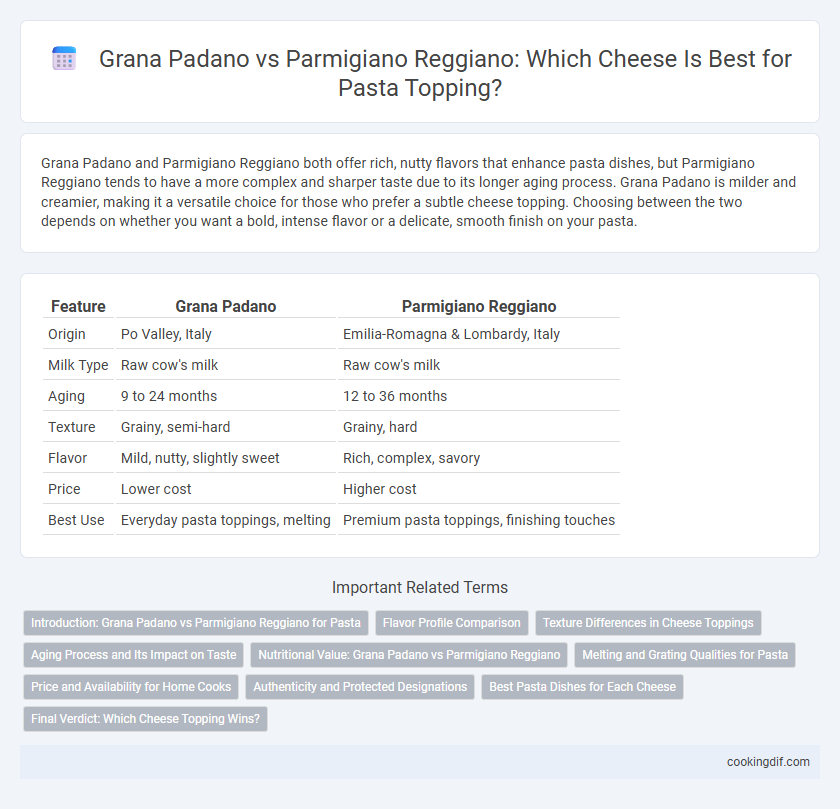Grana Padano and Parmigiano Reggiano both offer rich, nutty flavors that enhance pasta dishes, but Parmigiano Reggiano tends to have a more complex and sharper taste due to its longer aging process. Grana Padano is milder and creamier, making it a versatile choice for those who prefer a subtle cheese topping. Choosing between the two depends on whether you want a bold, intense flavor or a delicate, smooth finish on your pasta.
Table of Comparison
| Feature | Grana Padano | Parmigiano Reggiano |
|---|---|---|
| Origin | Po Valley, Italy | Emilia-Romagna & Lombardy, Italy |
| Milk Type | Raw cow's milk | Raw cow's milk |
| Aging | 9 to 24 months | 12 to 36 months |
| Texture | Grainy, semi-hard | Grainy, hard |
| Flavor | Mild, nutty, slightly sweet | Rich, complex, savory |
| Price | Lower cost | Higher cost |
| Best Use | Everyday pasta toppings, melting | Premium pasta toppings, finishing touches |
Introduction: Grana Padano vs Parmigiano Reggiano for Pasta
Grana Padano and Parmigiano Reggiano are two of the most popular cheeses used for topping pasta, both offering distinct flavors and textures. Grana Padano has a milder, slightly buttery taste with a softer texture, making it suitable for delicate pasta dishes, while Parmigiano Reggiano delivers a sharper, nuttier flavor and a granular texture that adds depth to hearty sauces. Choosing between these cheeses depends on the desired intensity of flavor and the type of pasta recipe being prepared.
Flavor Profile Comparison
Grana Padano offers a milder, slightly sweet and nutty flavor with a smooth texture, making it ideal for delicate pasta dishes. Parmigiano Reggiano provides a more robust, complex taste featuring sharp, savory, and fruity notes with a granular texture that enhances rich, hearty sauces. Choosing between them depends on the desired intensity, with Parmigiano Reggiano delivering a stronger, more pronounced flavor profile compared to the subtler Grana Padano.
Texture Differences in Cheese Toppings
Grana Padano offers a slightly softer, creamier texture with fine, evenly distributed crystals that melt smoothly over pasta, enhancing mouthfeel without overpowering. Parmigiano Reggiano features a firmer, granular texture characterized by larger, crunchy crystals that provide a robust bite and intense umami flavor. These textural differences influence the cheese's melting behavior and overall impact, with Grana Padano favoring a subtle creaminess while Parmigiano Reggiano delivers a more pronounced, complex topping experience.
Aging Process and Its Impact on Taste
Grana Padano undergoes an aging process ranging from 9 to 24 months, resulting in a milder, creamier flavor with subtle nutty notes ideal for delicate pasta dishes. Parmigiano Reggiano, aged between 12 and 36 months, develops a more complex, granular texture and a robust, savory flavor profile that enhances hearty pasta recipes. The extended aging of Parmigiano Reggiano intensifies its umami taste, making it distinctively sharper compared to the softer, sweeter profile of Grana Padano.
Nutritional Value: Grana Padano vs Parmigiano Reggiano
Grana Padano contains slightly less fat and sodium compared to Parmigiano Reggiano, making it a marginally lighter choice for cheese topping on pasta. Both cheeses are rich in protein and calcium, essential for muscle repair and bone health, but Parmigiano Reggiano offers a higher concentration of these nutrients per serving. Vitamin A and B12 levels are comparable, supporting vision and energy metabolism in dishes enhanced with either cheese.
Melting and Grating Qualities for Pasta
Grana Padano offers a smoother melt and slightly milder flavor, making it ideal for a creamy pasta topping, while Parmigiano Reggiano provides a sharper, more robust taste with a granular texture perfect for grating over dishes. Both cheeses have excellent melting properties but Parmigiano Reggiano's aged crystals enhance grating efficiency and release intense umami when freshly grated. The choice depends on whether a delicate melt or a bold, textured sprinkle is desired to elevate pasta flavors.
Price and Availability for Home Cooks
Grana Padano is generally more affordable than Parmigiano Reggiano, making it a popular choice for home cooks on a budget. Both cheeses are widely available in supermarkets, but Parmigiano Reggiano can be harder to find in smaller grocery stores due to its higher price and strict production standards. For everyday pasta dishes, Grana Padano offers great value without compromising the authentic Italian flavor.
Authenticity and Protected Designations
Grana Padano and Parmigiano Reggiano are both authentic Italian cheeses with Protected Designations of Origin (PDO), ensuring strict production standards and regional authenticity. Parmigiano Reggiano, produced exclusively in specific provinces of Emilia-Romagna and Lombardy, undergoes a longer aging process, contributing to its intense flavor profile, while Grana Padano is made in a wider area across the Po River Valley with a slightly shorter aging period. Choosing Parmigiano Reggiano or Grana Padano for pasta toppings guarantees a genuine Italian culinary experience grounded in tradition and quality control.
Best Pasta Dishes for Each Cheese
Grana Padano, known for its mild and slightly nutty flavor, pairs perfectly with light pasta dishes like risotto, fettuccine Alfredo, and simple vegetable pastas, enhancing without overpowering. Parmigiano Reggiano's robust, aged, and crystalline texture complements rich pasta recipes such as classic spaghetti Bolognese, lasagna, and carbonara, adding depth and a sharp umami crunch. Using the right cheese elevates the dish by balancing flavors and textures, making Grana Padano ideal for subtle recipes and Parmigiano Reggiano the choice for hearty, bold pasta meals.
Final Verdict: Which Cheese Topping Wins?
Grana Padano and Parmigiano Reggiano both offer rich, nutty flavors ideal for pasta, but Parmigiano Reggiano's complex aging process and granular texture provide a more intense, savory profile prized by chefs worldwide. Grana Padano, with its milder taste and slightly creamier consistency, suits lighter pasta dishes or everyday meals without overwhelming delicate flavors. For a definitive cheese topping that elevates pasta with depth and authenticity, Parmigiano Reggiano emerges as the superior choice.
Grana Padano vs Parmigiano Reggiano for cheese topping Infographic

 cookingdif.com
cookingdif.com